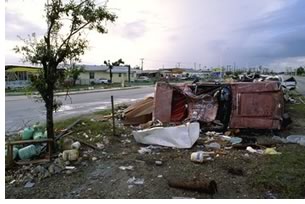

Go a Day Early to the AIA Convention, Maximize Your Learning Power
The pace of registration is ahead of the curve compared to past years for the AIA Convention June 10–12 in Chicago, and programs are filling fast. You can still earn all your AIA Continuing Education learning units for the year, though, especially if you go a day early and take advantage of one or more of the 29 full- and half-day education programs. The American Architectural Foundation is convening a full-day symposium on K–12 design education as well. Here is a review of that program and a small sampling of the others that still have spaces available.
WE01 Training Architects to Help Communities
Recover From Disaster
8 a.m.–noon, 3.75 HSW LUs
Standing among the stately oaks and antebellum mansions in Charleston,
S.C., it is hard to fathom that 14 years ago a hurricane named “Hugo”
cut a destructive path through Charleston’s historic commercial
and residential districts. Teaming with state and local officials, architects
played a crucial role with recovery and reconstruction efforts—restoring
the city within a few years to its world-renown charm.
 Led
by Charles F. Harper, FAIA,
chair of the AIA Disaster Response Committee, and 2004 Whitney Young Citation
recipient Terrance J. Brown, FAIA, this workshop will highlight the architect’s
integral role with disaster relief programs, focusing on collaborative
initiatives with the government and private sectors to restore the visual
quality and structural integrity of livable communities following catastrophic
loss. William C. Burke, director of the Illinois Emergency Management
Agency, will provide opening remarks.
Led
by Charles F. Harper, FAIA,
chair of the AIA Disaster Response Committee, and 2004 Whitney Young Citation
recipient Terrance J. Brown, FAIA, this workshop will highlight the architect’s
integral role with disaster relief programs, focusing on collaborative
initiatives with the government and private sectors to restore the visual
quality and structural integrity of livable communities following catastrophic
loss. William C. Burke, director of the Illinois Emergency Management
Agency, will provide opening remarks.
“Recent years have shown us the tragic consequences rendered by natural and human forces alike,” Harper says. “Because the general public is the direct beneficiary of our expertise, disaster preparedness and response is a prime tenet of architectural practice.” You’ll learn how to:
- Help a community in the three stages of disaster recovery: emergency, relief, and recovery
- Assess damage to structures
- Work with other entities providing disaster-recovery assistance.
WE04 Architect’s Essentials of Professional
Development: Learning and Competitive Edge
8 a.m.–noon, 3.75 LUs
A firm’s competitive edge relies on its distinct culture, skills,
and knowledge—all enhanced through professional development. Learn
how to create an in-house learning program that will sharpen your firm’s
identity, institutionalize technical excellence and innovation, and address
basic leadership attributes in daily practice. You’ll:
- Understand how clients interpret firm culture and skills
- Learn how to identify and address weaknesses and strengths and stimulate quality and leadership through a strategic internal professional development program
- Prepare a personal action plan for implementing techniques learned.
WE13 Grow Your Practice: Interiors as
an Advantage
8:30 a.m.–5:30 p.m., 7.5 LUs
A practical dialogue on growing your practice through interior architecture
and addressing the challenges of succeeding in a competitive market, this
program will feature interactive discussions and hands-on problem solving.
You will gain the business information and knowledge to expand and diversify
practice. You will:
- Explore alternative business applications and how to transform current practices into creative and innovative models
- Identify your skills and position them to the marketplace, becoming a catalyst for new business relationships
- Discover new ways to do the business of architecture.
 Design
Is a Catalyst for Learning
Design
Is a Catalyst for Learning
10 a.m.–6 p.m., National-Louis University, 122 South Michigan Ave.,
5 LUs
If architects know what an engaging and interdisciplinary activity design
is, then why isn’t it being taught more in schools? Unfortunately,
within most schools, architecture has a small, if not nonexistent footprint
in the curriculum. This fact, coupled with the current emphasis on testing,
points to the need to do more, outside the classroom and in the community,
to educate youth about design and use design to educate youth.
There are design education programs of value and quality across the country, and several exemplary programs will be showcased at the American Architectural Foundation’s National Symposium on K–12 Design Education in Chicago on June 9, the day before the AIA National Convention. This event is an ideal session for practicing architects who want to take an active role in teaching youth about architecture in their communities but don’t know where to begin.
Copyright 2004 The American Institute of Architects.
All rights reserved. Home Page ![]()
![]()
 |
||
| For more information on all AIA Convention programs and to register, visit the AIA Convention Web site. For more information on the Design Is a Catalyst for Learning
symposium and to register, visit the American Architectural Foundation
Web site.
|
||